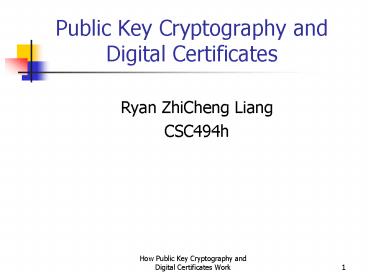Public Key Cryptography and Digital Certificates PowerPoint PPT Presentation
1 / 25
Title: Public Key Cryptography and Digital Certificates
1
Public Key Cryptography and Digital Certificates
- Ryan ZhiCheng Liang
- CSC494h
2
Table of Contents
- Why do we need cryptography
- Symmetric key and public key cryptography
- RSA algorithm for public key cryptography
- Public key certificate and its structure
- An example of authentication with certificates
3
Why do We Need Cryptography?
- Internet Security Issues
- Eavesdropping.
- Tampering.
- Impersonation.
4
Two Types of Cryptography Using Keys
- Terminology
- Plaintext unencrypted text.
- Cipher cryptographic algorithm.
- One way function A function which is hard to
reverse. - Key Is a word, number, or phrase that is used to
encrypt the plaintext - Symmetric Key Cryptography.
- Public Key Cryptography.
- (a.k.a Asymmetric Key Cryptography)
5
Symmetric Key Cryptography
- Use the same Key to encrypt and decrypt messages.
HNFmsEm6Un
Hey Bob
Hey Bob
Encryption
Decryption
ciphertext
Symmetric Key
Symmetric Key
Bob
Same key
Alice
6
Symmetric Key Cryptography (Contn)
- Drawbacks
- Transferring the symmetric key is prone to
security risks.
7
Public Key Cryptography
- Asymmetric Key Pair contains a public key and a
private key. - Use public key to encrypt and private key to
decrypt.
8
Private Key
- Kept and Protected by owner.
- Used to sign messages.
- Use to decrypt messages.
9
Public Key
- Distributed freely and openly.
- Used to verify signature.
- Use to encrypt messages.
- Key pairs are complementary.
- Information encrypted by public key can only be
decrypted by its own private key.
10
How Is Public Key Cryptography Used?
- Sign messages and verify signature.
- Encrypt and decrypt messages.
11
Sign and Verify Signatures
12
Encrypt and Decrypt Messages
HNFmsEm6Un
Decryption
Hey Bob
Encryption
Hey Bob
ciphertext
Bobs Public Key
Bobs Private Key
Bob
Different keys
Alice
13
RSA Algorithm
- Discovered by Ron Rivest, Adi Shamir, and Len
Adleman. - Main idea is to manipulate large integers by
modulus and exponentiation. - Security relies on the difficulty of factoring
large integer.
14
RSA Algorithm
- Step 1. Bob chooses large primes p and q, and
multiplies them to get n. - Step 2. Bob chooses a public exponent e such that
- (p 1) x (q 1) is not divisible by e.
- Step 3. Bob calculates a private exponent d e21
mod (p 1) x (q 1). - Step 4. Bob shares the public key, (e , n)with
Carol, and the Bobs private key is (d , n). - Step 5. Carol encrypts M to C with C Me mod
n, and sends C to Bob. - Step 6. Bob decrypts C back to M with M Cd mod
n.
15
RSA Algorithm Example
- 1. Bob chooses prime numbers p 5 and q 11,
then multiplies them to get modulus n 55. - 2. Bob calculates f(n) (p - 1) x (q - 1) 4 x
10 40. - 3. Bob chooses an e by which 40 is not divisible.
The factors of 40 are 2, 2, 2, 5, and 1, so Bob
chooses a private exponent e 3.
16
RSA Algorithm Example(Cont)
- 4. Bob chooses a public exponent d 321 mod 40.
This modular inverse function is actually
difficult, but for the small numbers we are using
we can see that 27 x 3 mod 40 81 mod 40 1. So
d 27. - 5. Now Bob's public key is the pair of numbers
(3, 55), and his private key is the pair of
numbers (27, 55). Bob gives Carol his public key.
17
RSA Algorithm Example(Cont)
- 6. Carol's message M 25. She encrypts it to
ciphertext - C 253 mod 55 15, 625 mod 55 5.
- Carol sends 5 to Bob.
- 7. Bob decrypts the ciphertext with
- M 527 mod 55 7,450,580,596,923,828,125 mod
55 25, which is Carol's original message.
18
What is a Public-Key Certificate?
- A certificate is an electronic document used to
identify an individual, a server, a company, or
some other entity and to associate that identity
with a public key. - Issued by Certificate Authorities(CA).
19
Certificate Structure
20
Certificate Structure(contn)
- Signature
- Is the hash value generated by applying CAs
private key on the certificate itself. - Plays an important role in verifying
certificates.(see example below)
21
A Real X.509 Certificate
- Data Version v3 (0x2) Serial
Number 3 (0x3) Signature Algorithm
PKCS 1 MD5 With RSA Encryption Issuer
OUAce Certificate Authority, OAce Industry,
CUS Validity Not Before
Fri Oct 17 183625 1997 Not After
Sun Oct 17 183625 1999 Subject CNJane
Doe, OUFinance, OAce Industry,
CUS Subject Public Key
Info Algorithm PKCS 1 RSA
Encryption Public Key
Modulus 437d456d714e173df
0364b5b7fa8 Public Exponent
65537 (0x10001) - Signature
- Algorithm PKCS 1 MD5 With RSA
Encryption Signature 6d23af
f3d3b67adf90dfcd7e186c
22
How are Certificates used?
- Client Server SSL Certificates.
- Object-signing certificates.
- Such as signing a Java Applet.
- CA certificates.
23
Example of Verifying Certificate
24
References
- Public key crytography
- http//en.wikipedia.org/wiki/Public_key
- Public key infrastructure implementation and
design Choudhury, Suranjan. - Digital signatures
- Atreya, Mohan. aut
- Internet security cryptographic principles,
algorithms, and protocols Rhee, Man Young.
25
Any Questions?

